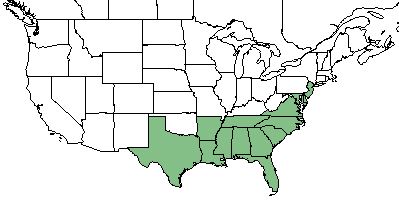Smilax walteri
| Smilax walteri | |
|---|---|

| |
| Photo by Craig Huegel hosted at Atlas of Florida Plants | |
| Scientific classification | |
| Kingdom: | Plantae |
| Division: | Magnoliophyta - Flowering plants |
| Class: | Liliopsida - Moncots |
| Order: | Lilales |
| Family: | Smilacaceae |
| Genus: | Smilax |
| Species: | S. walteri |
| Binomial name | |
| Smilax walteri Pursh | |

| |
| Natural range of Smilax walteri from USDA NRCS [1]. | |
Common Name(s): coral greenbriar;[1][2] red-berried swamp smilax[1]
Contents
Taxonomic Notes
Synonym(s): S. megacarpa[2]
Description
Smilax walteri is a monoecious perennial shrub or vine.[2]
Distribution
This species is found on the coastal plain from the eastern edge of Texas, eastward to central peninsular Florida, north to New Jersey and inland to Tennessee.[1][2]
Ecology
Habitat
S. walteri is found in swamp forests, bogs, and other areas that are often submerged for a portion of the year.[1] In the Okefenokee Swamp, southern Georgia, S. walteri had an above water biomass of 12 g m-2 with a productivity of 6 g m-2 yr-1.[3] In Tupelo gum-Cypress-swamp black gum communities of Alabama, S. walteri occurred at densities of 12 acre-1 (30 hm-2).[4]
Phenology
Flowering occurs from April through May and fruiting occurs from September through November but can persist beyond.[1]
Use by animals
Fruit remains of S. walteri have been found in deer pellets during May in eastern Texas.[5] Its fruits are also consumed by a variety of birds.[6] Leaves and twigs are consumed by the Florida marsh rabbit (Sylvilagus palustris paludicola).[7]
Conservation and Management
Cultivation and restoration
Photo Gallery
References and notes
- ↑ 1.0 1.1 1.2 1.3 1.4 Weakley AS (2015) Flora of the Southern and Mid-Atlantic States. Chapel Hill, NC: University of North Carolina Herbarium.
- ↑ 2.0 2.1 2.2 2.3 USDA NRCS (2016) The PLANTS Database (http://plants.usda.gov, 19 January 2018). National Plant Data Team, Greensboro, NC 27401-4901 USA.
- ↑ Schlesinger WH (1978) On the relative dominance of shrubs in Okefenokee Swamp. The American Naturalist 112(987):949-954.
- ↑ Hall TF, Penfound WT (1943) Cypress-gum communities in the blue girth swamp near Selma, Alabama. Ecology 24(2):208-217.
- ↑ Lay DW (1965) Fruit utilization by deer in southern forests. The Journal of Wildlife Management 29(2):370-375.
- ↑ White DW, Stiles EW (1992) Bird dispersal of fruits of species introduced into eastern North America. Canadian Journal of Botany 70:1689-1696.
- ↑ Blair WF (1936) The Florida marsh rabbit. Journal of Mammalogy 17(3):197-207.